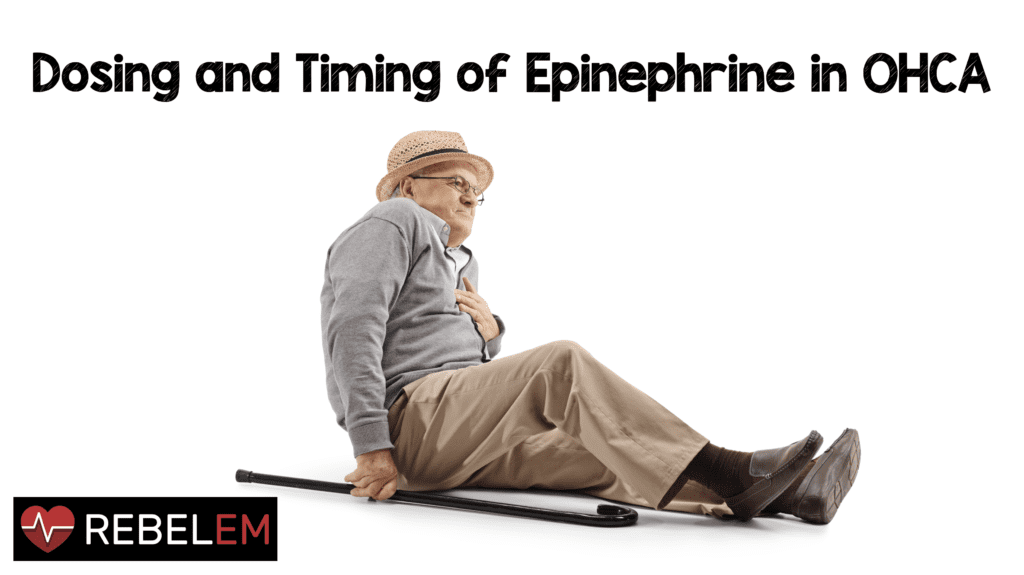

What They Did:
- Retrospective observational study of the Penn Alliance for Therapeutic Hypothermia (PATH) data registry
- Timing of the first dose of adrenaline and the total dose of adrenaline during cardiac arrest compared between survivors to discharge and non-survivors lasting greater than 10 minutes
Outcomes:
- Association between epinephrine timing and dosing on survival and neurologic function of survivors as defined by the Cerebral Performance Category (CPC )
Inclusion:
- OHCA
- At least 10 minutes of resuscitative efforts (defined by the interval from arrest onset to ROSC or termination of resuscitation efforts)
- Shockable rhythm
Exclusion:
- In-hospital cardiac arrest
- Non-shockable rhythm
- No adrenaline given
Results:
- 5594 patients in registry
- 2150 patient with in-hospital arrest or missing data excluded (It is unclear from manuscript how many were in-hospital arrest & how many had missing data)
- 3444 patients with out-of-hospital cardiac arrest
- 1826 patients had data on dose of adrenaline
- 1268 patients had data on timing of adrenaline
- Survivors to Discharge:
- Received adrenaline sooner (median 5.0 vs 7.0min; p = 0.022)
- Received lower doses of adrenaline (2.0 vs 3.0mg; p = 0.001)
- Survivors and Neurologic Outcomes:
- No significant association between time to first adrenaline dose and favorable neurological outcome
- Patients receiving <2mg of adrenaline vs patients receiving >3mg were more likely to have a favorable neurological outcome (CPC 1 – 2: 16.6% vs 12.5%; p = 0.004)
Strengths:
- Investigates a clinically important question
- The PENN Alliance for Therapeutic Hypothermia (PATH) database is used by 34 institutions in which a minimum of at least 30 variables is submitted for in-hospital and out-of-hospital cardiac arrests
- To ensure data quality, the PATH database manager reviews a random sample of 15% of cases submitted from all institutions
Limitations:
- Significantly more patients with ROSC who did not require epinephrine received therapeutic hypothermia and PCI than in the epinephrine cohort, however, few of the survivors had timing of epinephrine recorded in the registry limiting analysis on the influence of post-resuscitative care on outcome. This is a marker of quality of care (i.e. therapeutic hypothermia and PCI indicate a higher level of care)
- Timing of the first dose of adrenaline is not clearly defined in this manuscript. Was it from time of arrest, or time from arrival of EMS/advanced providers?This information is not clear from the manuscript
- Retrospective study performed on registry data making the data only as good as the data collection. Would argue data not great as lots of patients excluded due to missing data
- Methods are sparse. Not much on chart review methods, nothing on how many researchers extracted information, or degree of agreement between extractors
- Not all participants in the registry were required to complete the same number of data elements, meaning there was a lack of complete information on all the patients entered into the registry
- As this is a retrospective observational study, only associations and not causations can be commented on between the timing and total dose of epinephrine with survival and survival with goo neurological outcomes.
Discussion:
- Epinephrine is a double-edged sword (Save the Heart at the Expense of the Brain):
- Alpha-agonist – improves coronary perfusion and aortic diastolic pressures
- Beta-agonist – increases myocardial work, promotes dysrhythmias, and increases platelet activation and clot formation causing potential adverse effects on neurologic injury and recovery
- Therapeutic Hypothermia:
- Epi Group: 45.7%
- No Epi Group: 66.4%
- PCI:
- Epi Group: 55.6%
- No Epi Group: 100%
Author Conclusion: “Early adrenaline administration is associated with higher percentage of survival to discharge but not associated with favorable neurological outcome. Those patients with a favorable neurologic outcome received a lower total adrenaline dose prior to ROSC.”
Clinical Take Home Point: The exact dose and timing of epinephrine is still not known in OHCA. This studies conclusions point us in a direction of earlier dosing and lower dosing to help improve survival with good neurological outcomes in patients with shockable rhythms, OHCA, and lasting >10minutes. Unfortunately, the methodology of this study is limited by lack of specific definitions of timing, and missing data, making the conclusions of this study hypothesis generating at best.
References:
- Sigal AP et al. Impact of Adrenaline Dose and Timing on Out-of-Hospital Cardiac arrest Survival and Neurological Outcomes. Resuscitation 2019. PMID: 30991079
- Nakahara S et al. Association Between Timing of Epinephrine Administration and Intact Neurologic Survival Following Out-of-Hospital Cardiac Arrest in Japan: A Population-Based Prospective Observational Study. Acad Emerg Med 2012. PMID: 22805628
Post Peer Reviewed By: Anand Swaminathan, MD (Twitter: @EMSwami)
The post Dosing and Timing of Epinephrine in OHCA appeared first on REBEL EM - Emergency Medicine Blog.
